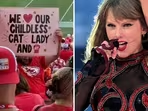These Wizard of Oz Secrets Will Make You Feel Right at Home
When The Wizard of Oz opened in theaters—make that movie palaces—on Aug. 25, 1939, audiences weren't immediately blown away by the cinematic marvel.
Starring Judy Garland as Dorothy Gale, a girl living on a sepia-toned Kansas farm who finds herself in the Technicolor land of Oz after a tornado carries her house over the rainbow (or maybe she had an epic dream thanks to a bump on the head), the MGM production was nominated for five Oscars, but only made about $3 million after costing $2.7 million to make.
Luckily MGM had the brains, heart and courage to re-release the movie in 1949, when it raked in $26 million and finally became a hit.
And one or two—or a few dozen—elements of the film have been embedded in our culture ever since, from the ubiquitous "Over the Rainbow" and countless quotable lines ("I have a feeling we're not in Kansas anymore" knows no geographical bounds!) to the popularization of the word "munchkin" to refer to a cute little kid.
"When I was 4 or 5, I watched The Wizard of Oz, and for a year, I asked [my mom] to call me Dorothy," Megan Fox told the New York Times in 2009. "When my mom explained to me that Dorothy was not real, that an actress plays her, I decided I wanted to be an actress."
Amy Adams, meanwhile, went off to see the wizard at least once to the tune of Pink Floyd (more on that later), telling Rotten Tomatoes in 2010, "Have you done the watching it with the Dark Side of the Moon? You should really do that, it’s very strange."
And the whole Wizard of Oz aesthetic inspired Greta Gerwig's Barbie with its "incredible soundstages, and these painted skies, and this sense of, I say, 'authentically artificial,' which I think is very beautiful and emotional," the director told Letterboxd in 2023. "I think of the painted backdrop of the Emerald City as they go towards it. In our movie, we have the Pink Brick Road instead of the Yellow Brick Road."
Plus, countless stagings, sequels and reimagining over the years—including the revisionist prequel Wicked, which started as a novel, became a smash Broadway show and is now an upcoming two-film extravaganza starring Ariana Grande and Cynthia Erivo—have made for an unlimited Oz universe.
But the original movie remains one of a kind. While we can't promise to make all your troubles melt like lemon drops, we encourage you to come out from wherever you are and follow-follow-follow-follow along for a peek behind the curtain at these secrets about The Wizard of Oz:
There's no such thing as a simpler time when it comes to the business of making movies. The Wizard of Oz was a tumultuous production from the start.
Producers Arthur Freed and Mervyn LeRoy both took credit for pitching the idea of a big screen musical based on Frank L. Baum's classic children's tale The Wonderful Wizard of Oz to MGM honcho Louis B. Mayer.
They went through four directors, more than a dozen writers—including Citizen Kane scribe Herman J. Mankiewicz and poet Ogden Nash—and multiple cast changes before everyone was in place for the long haul.
The screenwriters who ended up with the credit for adapting Baum's story were Noel Langley, Florence Ryerson and Edgar Allen Woolf.
When MGM first bought the rights to Baum's saga, Mayer envisioned 9-year-old Shirley Temple as Dorothy (the child's last name, Gale, wasn't revealed until the third book in the series, Ozma of Oz), and W.C. Fields as The Wizard.
Meanwhile, MGM cofounder Samuel Goldwyn wanted Eddie Cantor for the part of Scarecrow.
Judy Garland, however, had been under contract with MGM since she was signed in 1935 at the age of 13.
And studio contracts tended to rule the day: 20th Century Fox refused to loan Temple to MGM, and then Mayer's second pick for Dorothy, Deanna Durbin, was unavailable.
Producers Freed and LeRoy had wanted Garland—who till then was most known for her pairings with Mickey Rooney in the likes of Love Finds Andy Hardy—from the start and the 16-year-old was cast as Dorothy in 1938.
The role of Scarecrow of course went to vaudeville star Ray Bolger, who was so light on his feet he could believably have been made of straw.
In fact, Joaquin Phoenix studied Bolger's moves to inform his Oscar-winning approach to being up in his own head and dancing in 2019's Joker.
Dorothy's beloved terrier Toto was played by a Brindle Cairn Terrier named Terry.
She was paid $125 a week—more than the actors who played the Munchkins—and after stealing the show in Oz, she went professionally by Toto to capitalize on her fame.
She appeared in 13 movies overall before she passed away in 1945 at the age of 11. You can visit a memorial paying tribute to the pup at Hollywood Forever Cemetery.
Director Victor Fleming left before The Wizard of Oz was completely done when powerful producer David O. Selznick plucked him off the movie to replace George Cukor behind the camera on Gone With the Wind.
Cukor was known as a real actress whisperer who bonded with his leading ladies, so, while Vivian Leigh and Olivia de Havilland were having a lovely time, Clark Gable was fuming.
King Vidor was called in to shoot the beginning and end of the film, the black and white scenes set in Kansas.
He was uncredited at the time, but check IMDb, because tons of cast and crew—including all the actors who played Munchkins—were originally uncredited for their work on this film.
A frequent occurrence when it comes to old movies (and newer movies that involve script-doctoring, etc.), but still a wrong that needed writing.
Back in the day, studios didn't want movies to be too long. When the original cut of Oz came in at two hours, it was ordered whittled down.
One suggestion was to cut Dorothy singing "Over the Rainbow," but they wisely left one of the most iconic movie songs ever intact and trimmed elsewhere, ultimately clocking in at 101 minutes.
While they didn't film in any exotic locales—or even in Kansas—the shoot lasted from October 1938 through March 1939 and required 29 sound stages and 65 sets, making The Wizard of Oz one of the most lavish productions of its day.
It was rivaled that year in spectacle only by Gone With the Wind, the only other 1939 release using the newest Technicolor technology.
More than 55 years before Twister barreled through town, the tornado in The Wizard of Oz was considered pretty darn scary. And making it look realistic was a labor of love for special effects supervisor A. Arnold Gillespie.
After a 35-foot rubber cone failed to look like a cyclone was really coming for Dorothy's house, Gillespie fashioned a massive windsock—a truncated cloth cone open at both ends—made out of muslin and chicken wire, the design inspired by windsocks you see at the airport today.
He blasted it with compressed air and, voila, it's the tornado that sends our heroine flying over the rainbow.
An acre of fake poppies were wired to the floor of sound stage 29 at MGM for the scene in which the Wicked Witch of the West puts a sleeping spell on the flowers afar in her attempt to keep Dorothy from reaching the Emerald City.
Dorothy's Ruby Slippers were played by six pairs of hand-bedazzled shoes, the sequins and painted beads sewed on by workers from the film's costume and wardrobe department headed up designer Adrian.
Four pairs worn by Garland in the film are known to have survived, including a pair bought at auction from MGM for $15,000 and donated in 1979 to the Smithsonian. That painstakingly restored pair is on display at the Smithsonian's National Museum of American History in Washington, D.C., the center of an exhibit which also includes items such as Scarecrow's hat and Glinda's wand.
Nine years before it opened, a pair was purchased in 2012 to go on display at the years-in-the-building Academy Museum of Motion Pictures in L.A. for $2 million.
Singin' in the Rain star Debbie Reynolds bought a pair that was only used in screen tests for $300 and sold them to an anonymous buyer in 2011 for $627,300.
One of the movie pairs disappeared from the Judy Garland Museum (converted from her childhood home) in Grand Rapids, Minn., in 2005, the thieves leaving a single sequin behind. The owner who donated them received an $800,000 insurance payout.
While the Smithsonian pair was undergoing a 200-hour conservation process, the FBI recovered the stolen pair in a 2018 sting operation and called up the museum experts to confirm their authenticity. It turned out the recovered "traveling pair" of slippers were the long lost twins of the Smithsonian shoes.
Margaret Hamilton kinda went through hell to play the bicycle-riding Miss Gulch and broomstick-flying Wicked Witch of the West.
The actress and her stuntwoman Betty Danko were injured filming the scene in which the witch appears and disappears from Munchkinland in a flash of red smoke.
Danko was hurt when a crew member fell through an aluminum-covered hole in the stage, under which Danko was waiting to be catapulted upward with the smoke, and fell on her shoulder, according to Aljean Harmetz's The Making of The Wizard of Oz.
That left Hamilton to do the scene on her own. They got the shot, the crew installing an elevator to lift her up in place of a catapult. But Fleming wanted more takes.
"I want this shot done right and done right now," Hamilton recalled Fleming's words to Harmetz, who described the actress in his book as "the kindest of witches."
Four takes weren't quite right. On the fifth, smoke and flames shot out before Hamilton was safely squirreled back under the stage and she suffered second-degree burns on her face and third-degree burns on her hands.
She was out of commission for six weeks. And when she was on set, the green copper-based makeup she was wearing required acetone (the key ingredient in nail polish remover) to be removed.
"I'll never, as long as I live," she told Harmetz, "have anything that [takes] my breath away like that pain."
Only 17 at the time, Garland was presented with the Academy Juvenile Award for her performance in The Wizard of Oz. (Here she is at the 1940 ceremony being congratulated by dear friend and frequent costar Mickey Rooney.)
Oz was nominated for five Oscars—Best Picture, Art Direction, Special Effects (which then included visuals and sound), Original Song and Score—but only won two, for composer Harold Arlen and lyricist E.Y. Harburg's undeniable "Over the Rainbow" and Herbert Stothart's score.
The year just happened to be stacked and Oz ran into the juggernaut that was Gone With the Wind's 10 Oscars, including Best Picture and Best Director for the man who directed most of The Wizard of Oz, Victor Fleming.
Meanwhile, the Academy eventually changed the age limit, allowing Tatum O'Neal to become the youngest-ever competitive-Oscar winner at 10, Best Supporting Actress for Paper Moon in 1974.
Crank up Pink Floyd's 1973 album Dark Side of the Moon just as MGM's Leo the Lion is roaring for the third time before The Wizard of Oz begins, and boom, you're doing The Dark Side of the Rainbow.
Dorothy running away from home as Roger Waters sings "No one told you when to run." The tornado bucking and swirling to "The Great Gig in the Sky." The beat of a heart as Dorothy presses her ear against the Tinman's regrettably hollow chest.
We don't know how the music and lyrics synced up to the action in the movie, they just do.
"I've watched The Wizard of Oz, listening to The Dark Side of the Moon, while high on marijuana," Waters said on The Joe Rogan Experience in 2023. "And if it's not on purpose, it is a cosmic coincidence because it's kind of amazing. It's kind of amazing how it just flows."
Journalist Charles Savage first popularized the pairing in a 1995 article for the Fort Wayne Journal Gazette, explaining that he read about it online in a Pink Floyd newsgroup (a precursor to Reddit). He rented a copy of the movie on VHS and called the experience "astonishing."
While we're on the freakier side of the rainbow, we'll take the opportunity to reiterate that no member of the cast took his own life on set during the making of The Wizard of Oz.
But it's an enduring urban legend that an actor playing a Munchkin hanged himself, the moment was captured on camera and you can see it if you know when to look.
While anyone (present company included) can be made to see it and wonder, MGM maintained that the shadowy movement in the background as Dorothy, Tinman and Scarecrow skip down the Yellow Brick Road was a crane (as in a bird) that Fleming enlisted along with some other animals from the Los Angeles Zoo to make the forest seem more alive. (There are a lot of painted backgrounds in the film.)
Moreover, other reports debunking this rumor relay that the actors playing Munchkins weren't due to arrive on set until after the sequence in which the Tinman joins Dorothy and Scarecrow on their journey was shot.
Rumor also had it—thanks to the stars of the movie, no less—that the little people cast as the residents of Munchkinland ran amok in their free time.
"They were little drunks," Garland said in a 1967 interview with Jack Paar. "They got smashed every night and the police used to scoop them up in butterfly nets."
Jerry Maren, who played the green plaid-wearing member of the Lollipop Guild and was the last surviving Wizard of Oz Munchkin when he died at 98 in 2018, pushed back at the characterization of him and his costars.
"Judy was telling it according to her pills and booze that day," Maren wrote in his 2006 memoir (with Stephen Cox) Short and Sweet: The Life and Times of the Lollipop Munchkin. "She left behind a legacy of untruths about us."
And among the 120 or so little people in the film, "There were a couple of kids from Germany who liked to drink beer," he wrote. "They drank beer morning, noon and night, and got in a little trouble. They wanted to meet the girls, but they were the only ones."
Margaret Pellegrini, who played a Munchkin villager, had fond memories of the experience. "My father worked in a hotel and earned about $5 a week. I got paid $50 a week," she recalled. "It took eight weeks to make the Munchkinland scenes, after which I stayed in Hollywood for a month to sightsee."
While playing Dorothy made her one of the biggest stars in Hollywood, Garland—who'd been singing and dancing professionally since she was a little girl—her life was already taking a turn for the tragic.
MGM—which first signed the multitalented actress in 1935, when she was 13—was on her case to lose weight, and she was given amphetamines to keep her up and suppress her appetite and downers to get her to sleep.
"I always have to be my best in front of the camer," Garland told her future second husband, Vincente Minnelli, when he directed her in the 1944 MGM musical Meet Me in St. Louis, per Gerald Clarke's 2000 biography Get Happy: The Life of Judy Garland. "You expect it of me too. Well, sometimes I don't feel my best. It's a struggle to get through the day. I use these pills. They carry me through."
In his posthumous 2017 memoir Judy and I: My Life With Judy Garland, her third husband Sid Luft wrote, "Judy admitted she felt she grew inches when she took Benzedrine. The extra 'bennie' gave her the courage to march 10 feet tall."
Garland died of an accidental overdose of barbiturates in 1969. She was 47.
Disclaimer: The copyright of this article belongs to the original author. Reposting this article is solely for the purpose of information dissemination and does not constitute any investment advice. If there is any infringement, please contact us immediately. We will make corrections or deletions as necessary. Thank you.
Title:These Wizard of Oz Secrets Will Make You Feel Right at Home
Url:https://www.investsfocus.com







